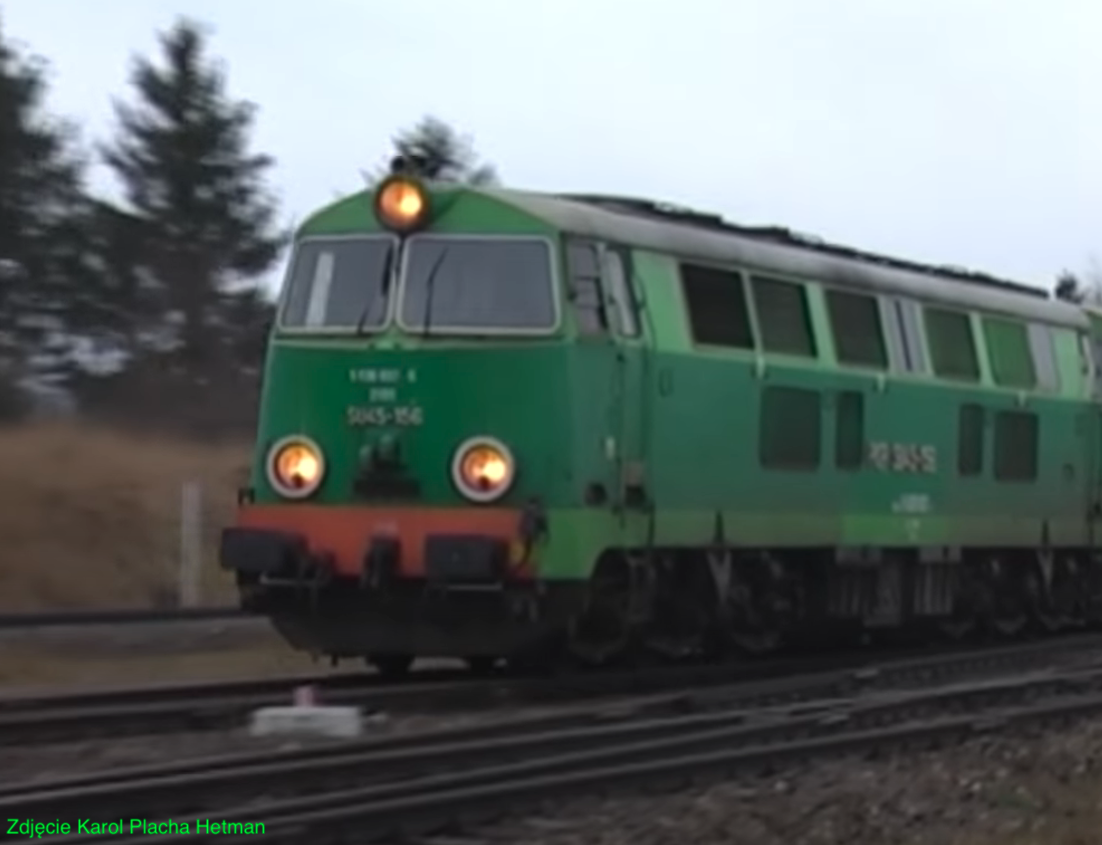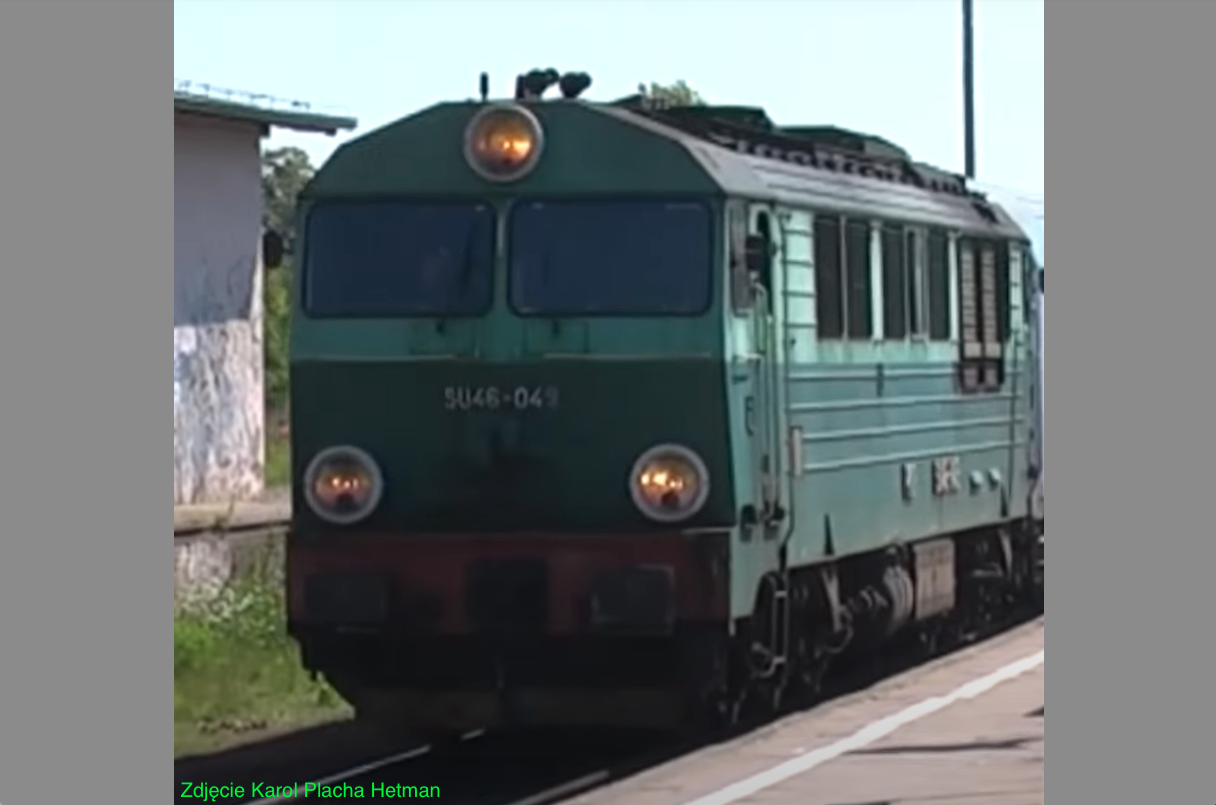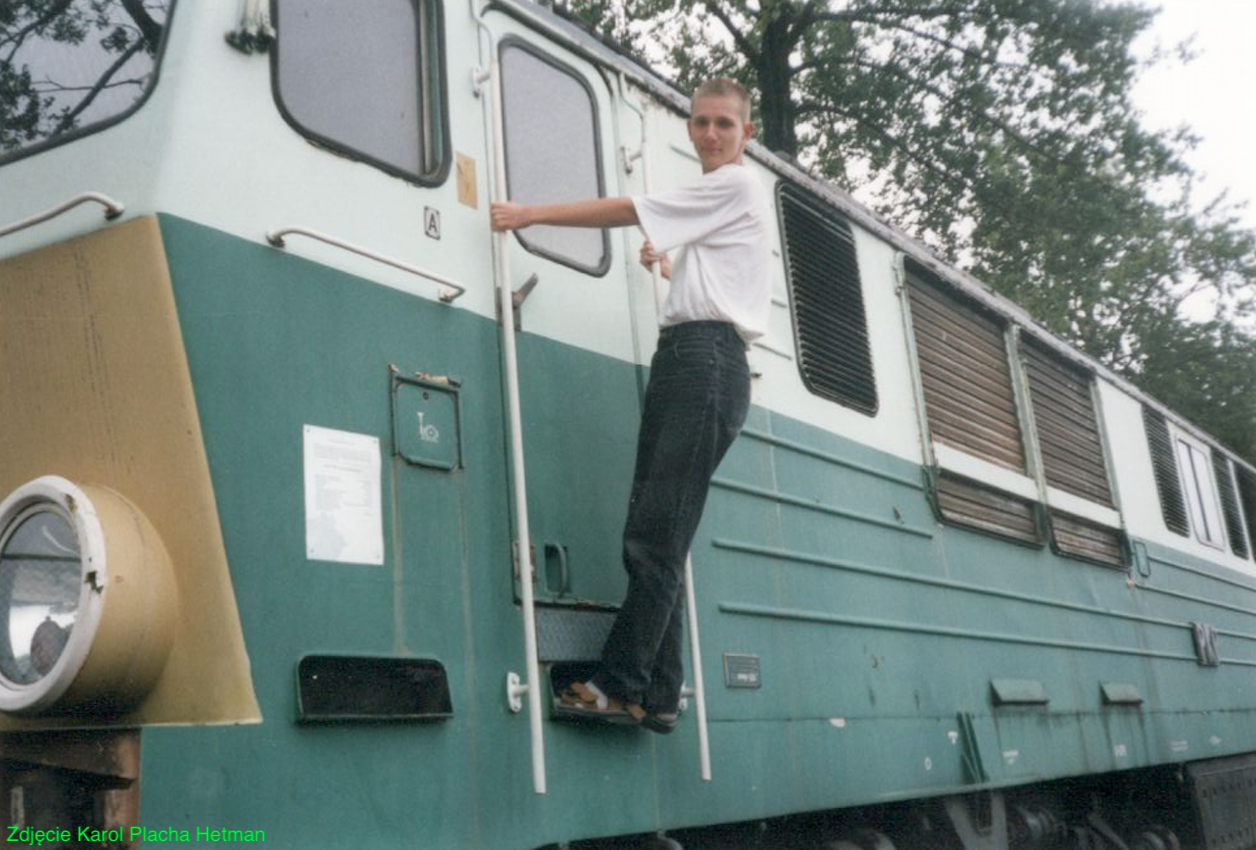Kraków 2023-02-23
Diesel locomotives in Poland.
HCP type 301D series SP45 / SU45.
In 1967, the HCP factory in Poznań built a prototype of the 301D locomotive of the SP45 / SU45 series. In the period 1967 - 1976, 270 copies were built. Initially, the locomotives in PKP received the designation SP45 (passenger diesel). The changes made to the locomotives resulted in a change of designation to SU45. The locomotives worked on non-electrified routes with passenger and freight trains. The locomotives were called FIAT due to the origin of the engine.
T-T data of the HCP 301D locomotive: Co'Co' axle arrangement. Length 18.90 m. Width 2.90 m. Height 4.24 m. Service weight 102,000 kg. Wheel diameter 1.10 m. FIAT 2112SSF diesel engine, 1,750 HP (1,250 kW). Capacity of fuel tanks 3,200 - 3,500 liters. Design speed 120 km/h. Electric transmission. Multiple control. Engine oil consumption is 36 liters per hour, while fuel consumption is 223 g/kWh (164 g/KMh).
Both engines and main generators for the new locomotive were to be manufactured in Poland. In 1967, the first prototype of the HCP 301D locomotive was built, which was equipped with a Polish 12C22W, 12-cylinder engine with a power of 1,520 HP. The engine was developed by Polish engineers on the basis of a smaller a8C22 engine that powers SM42 series locomotives. The engine needed fine-tuning, which could take several years. Therefore, a license for the FIAT 2112SSF engine was purchased and its production started in Poland at HCP. The 2112SSF engine is a diesel, turbocharged, 12-cylinder, four-stroke, volume 95,600 cm3, compression ratio is 11.3, power 1,750 hp, at 1,500 rpm.
During the tests, the HCP factory introduced many changes and corrections. During production, grooving of the locomotive body cover was introduced.
The heating system of the passenger cars was of the steam type. At that time, most passenger cars had this type of heating. Therefore, a steam boiler was installed in the locomotive, which was powered by diesel oil. Steam boilers were purchased abroad. In 1987, in connection with the introduction of passenger cars with electric heating in PKP, an electrical system for heating cars with electricity with a voltage of 3,000 V was introduced. The SU45 locomotive was fitted with a LCPb-400 type heating generator manufactured by the DOLMEL plant in Wrocław. The negative effect of this change was the deterioration of the performance of the SU45 locomotive, as the heating system consumed 400 kW of power from the combustion engine. In total, 191 copies were rebuilt. The works were carried out in the period 1988 - 1997. SP45 / SU45 locomotives, in which the heating was not modernized and the steam boiler was left, were scrapped or sold in 1999.
SU45 design. The locomotive has a Co'Co' axle arrangement. The locomotive body is self-supporting. Driver's cabins are installed at the ends of the body. In the middle compartment there is a 12-cylinder, four-stroke, supercharged 2112SSF diesel engine with a GP-846B1 main generator, manufactured by DOLMEL Wrocław, licensed by Alstom. The generator serves as a starter. Other equipment includes: air compressor, oil tanks, cooling unit, generator for heating LCPb-400 wagons with a power of 495kW. Six traction motors, type LSm-493 or type LSa-430, drive each axle of the locomotive. The engines are suspended by the tram system ("by the nose"). Between the bogies of the locomotive there are compartments housing batteries and water and fuel tanks (with a capacity of 3500 liters).
Traction motors type LSm-493: Rated voltage 725 V. Maximum voltage 850 V. Power 216 kW. Rated speed 553 rpm. Maximum speed 2,260 rpm. Engine weight 2,350 kg.
It is worth knowing that there were 3 export copies of 301Dc locomotives for CEL (Chemins de fer l'Etat Libanais - Lebanese Railways), initially marked as 301Dc-225L - 227L (numbering resulted from the order of serial numbers of HCP locomotives). Finally, according to the recipient's wishes, the locomotives were marked: No. 1201, 1202, 1203.


HCP type 303D series SU46.
The SU46 locomotive was developed in HCP in Poznań in 1974. The locomotives were produced in the period 1974 - 1977 and two locomotives in 1985. The locomotive is a development of the SU45 design. A total of 54 SU46 locomotives were produced. Production was stopped at the request of the authorities, because it was ordered to buy locomotives with CCCP ST44.
SU46 locomotive T-T data: Co'Co' axle arrangement. Length 18.99 m. Width 3.03 m. Height 4.29 m. Service weight 105,000 kg. Wheel diameter 1.10 m. W2112SSF diesel engine, 2,250 hp (1,654 kW). Capacity of fuel tanks 3,200 liters. Design speed 120 km/h. Electric transmission. Oerlikon brake system. 3,000 V electric heating system. The minimum radius of the curve is 100 m.
The design of the SU46 locomotive was created in 1972, in parallel with the SP47 locomotive. From the beginning, the SU46 locomotive had a 3,000 V electric heating system for the cars. The electricity is provided by a 9-phase LCPa-400 AC generator with a power of 440 kW with a rectifier system. The last locomotives, SU46-053 and SU46-054, have an LCPb-400 generator with a power of 495 kW.
The construction of the SU46 locomotive was successful. Many devices and aggregates manufactured in Poland have been installed in the locomotive. Many Polish design solutions were used. The air for cooling the traction motors is taken from the outside through the louvres, not from inside the box. The parking brake is hydraulic. Co'Co' axis system. A supercharged diesel engine, type W2112SSF, with a power of 2,250 hp (16,54 kW) was used, which was a modification of the FIAT engine type 2112SSF, with a power of 1,700 hp (1,250 kW), which was used to drive locomotives 301Db (SP45, SU45 ). The engine drives the GP846 B1 main generator (rated voltage is 725 V, rated current is 2,000 A, continuous power is 1,450 kW, rotational speed is 1,500 rpm, weight is 4,350 kg. The engine is equipped with a water heater, because the engine temperature must be +40 degrees C. This ensures a low failure rate of the engine.

HCP type 302D series SP47.
The SP47 locomotive was developed at the same time as the SU46 locomotive. The prototype of the SP47 locomotive was built in 1975. In the period 1975 - 1977, only 2 locomotives were built. Factory designation type 302D.
SP47 T-T data: Co′Co′ axle arrangement. Length 20.18 m. Width 3.03 m. Height 4.25 m. Service weight 114,000 kg. Wheel diameter 1.10 m. 16-cylinder, four-stroke engine, type W2116SSF, 2,200 kW. AC/DC electric transmission. Fuel tank capacity 5,500 liters. Design speed 140 km/h. Electric heating 3,000V.
The main difference in the SP47 locomotive compared to the previous ones was the use of a larger diesel engine. The base was the W2112SSF engine, to which four more cylinders were added. This is how the W2116SSF engine was created. The engine was connected to a three-phase alternating current generator, which was unique in the national railways at that time. The locomotive was intended to drive passenger trains at a speed of 140 km/h. Therefore, the bogies were modernized and it was planned to use monoblock wheels. Polish generators were used for heating. Under the body of the locomotive there is a fuel tank with a capacity of 5,500 liters, a battery cabinet and compressed air tanks. The locomotive suspension solution was the same as in the SU46 locomotive. The box with the support rested on each of the trolleys on four supports, cushioned by rubber elements. The locomotive has 6 LsB-493 DC electric motors, 310 kW each, which transmit power through a toothed gear. The engines are suspended in the tram way, "by the nose". The wheel axles are mounted on roller bearings. During use, the monoblock wheels of the foreign company SAB were replaced with Polish, ordinary wheels with spokes.
After the first tests, the maximum speed was limited to 120 km/h, because it turned out that the parameters of the main generator differed from the assumptions. In addition, it was feared that such a fast locomotive, not equipped with an electrodynamic brake at a speed of 140 km/h, might not achieve the required braking distance. The engineers wanted the locomotive to be as dynamic and failure-free as possible.
Both SP47 locomotives were handed over for trial operation. The vehicles drove express trains mainly on the Warsaw - Gdynia route. In the following years, due to the lack of spare parts, inspections and repairs took a long time. The communist authorities of Poland were not interested in refining the SP47 locomotive, because Russian ST44 locomotives were already imported. In 1991, SP47-002 suffered engine failure. The failure consisted in twisting the crankshaft and cracking the engine block. A similar failure occurred in 1997 on the SP47-001 locomotive. The SP47-001 locomotive went to the museum in Kościerzyna. The SP47-002 locomotive was scrapped in 2001.

Written by Karol Placha Hetman
